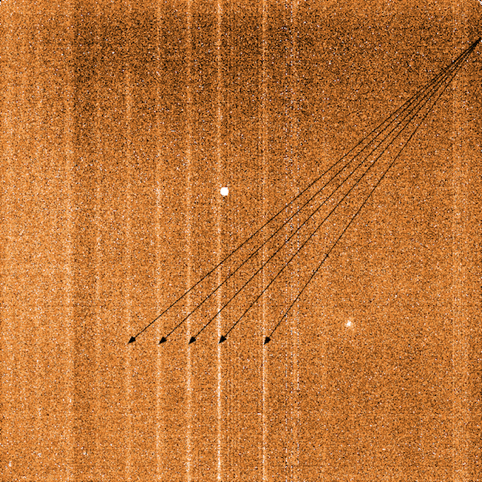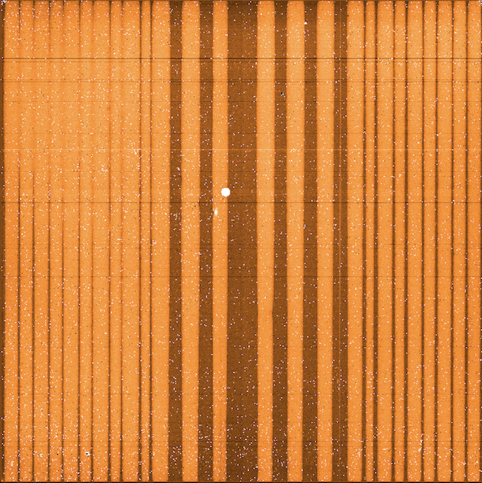Data processing of SINFONI data: Frequently asked questions
- Are there any known problems with SINFONI data?
Answer: The quality control group keeps a list of know problems at
http://www.eso.org/observing/dfo/quality/SINFONI/pipeline/problems.html
- What is the best way to reduce SINFONI data?
Answer: We recommend to use Reflex for all SINFONI data.
- Which pipeline data product are the important ones for quick inspection?
Answer: The most important products for a quick evaluation of SINFONI data are:
OBS_OBJ -- 3-D cube from individual exposure
COADD_OBJ -- coadded 3-D cubes
MED_COADD_OBJ -- 2-D image from collapsing the 3-D cubes in the spectra direction
- Why is it that sometimes the pipeline only produces individual cubes but not the final co-added cube or the 2-D co-added image?
Answer: By default, the sinfo_rec_jitter recipe has a limit on the size of the output cube set by objnod-mosaic_max_size; if that is exceeded (e.g. when a large area is mapped) then the final co-adding is not done. Increase objnod-mosaic_max_size if you need to combine a large mosaic.
- How do I combine the individual 3-D cubes into a final mosaic?
Answer: Select the cubes and run sinfo_utl_cubecombine. You will have to supply a list of cumulative offsets into the file offset.list. If the individual cubes come from a single offset sequence, the easiest is to use the ESO.SEQ.CUMOFFSETX/Y keywords in the header.
- What software can I use to quickly visualise SINFONI reduced data?
Answer: Recommended is QFitsView written by Thomas Ott, which runs on OSX, Linux and Windows.
It can be downloaded from http://www.mpe.mpg.de/~ott/QFitsView.
Programs such as ds9, IDL etc also have capabilities for displaying cube data.
- There seems to be an extraneous signal in my science image. Where does this come from?
Answer: SINFONI’s detector is very sensitive to high flux levels. If a very bright object is observed prior to your observations, some amount of this signal may persist into your exposures (hence the name “persistence”). This effect can best be seen in long darks taken immediately after the observation of a bright sources. In this figure, the remnant signal is pointed out:

Although the saturation level of the detector is 45000 ADUs, SINFONI observations must keep below about 1/6 of that to avoid detector persistence. Detector persistence would affect the subsequent observations of faint sources, and can take days to disappear, therefore this must be avoided. The current detector persistence limits are 6000, 7000, 8000 and 7000 ADUs per (detector) pixel for J, H, K and H+K respectively. This usually means no objects with J, H, K magnitudes < 6mag must be visible within a field of view of 15" around the AO guide star and/or the target.
There have been instances in which the SINFONI flat was over-exposed. If this occurs, the dark images can display larger regions affected by persistence. This is an example dark from 2011-03-20:

- I still see sky lines in my reduced data, why?
Answer: You should first check whether you have used the latest version of the pipeline and Reflex workflow. In some older versions, the sky subtraction is turned off by default.
If you want to check whether the sky subtraction is turned on, open the actor "Object Cube Creation" in the Reflex workflow, then use the mouse right button to configure the sinfo_rec_jitter recipe. The parameter stack-sub_raw_sky should be set to “true".
- The pipeline fails with an error similar to: Standard error: [ERROR] sinfo_rec_distortion: parsing cpl input etc. What is wrong, and how can I proceed?
Answer:
Standard error:
[ERROR] sinfo_rec_distortion: parsing cpl input
[ERROR] sinfo_rec_distortion: Dumping all 2 error(s):
[ERROR] sinfo_rec_distortion: [1/2]'An unspecified error: could not parse cpl input!' (1) at sinfo_new_lamp_flats.c:192
[ERROR] sinfo_rec_distortion: [2/2]'An unspecified error: reducing lampflats' (1) at sinfo_rec_distortion:sinfo_rec_distortion.c:362
[ERROR] esorex: Execution of recipe 'sinfo_rec_distortion' failed, status=-1
The problem stems from the fact that the CalSelector has failed to supply all of the necessary files for the SINFONI distortion recipe to work. (This sometimes does happen and we're working to rectify this.) You must have 75 fits files with DPR.TYPE = DISTORTION,FIBRE,NS, 2 fits files of DPR.TYPE = DISTORTION,FLAT,NS, and 2 fits files of DPR.TYPE = DISTORTION,WAVE,NS. The simplest way to retrieve this suite of files is to use the query form, using start and end dates near the time of your science data and setting DPR.TYPE to be DISTORTION. This will then return the full list of 79 files from which you can select those that are currently missing.
